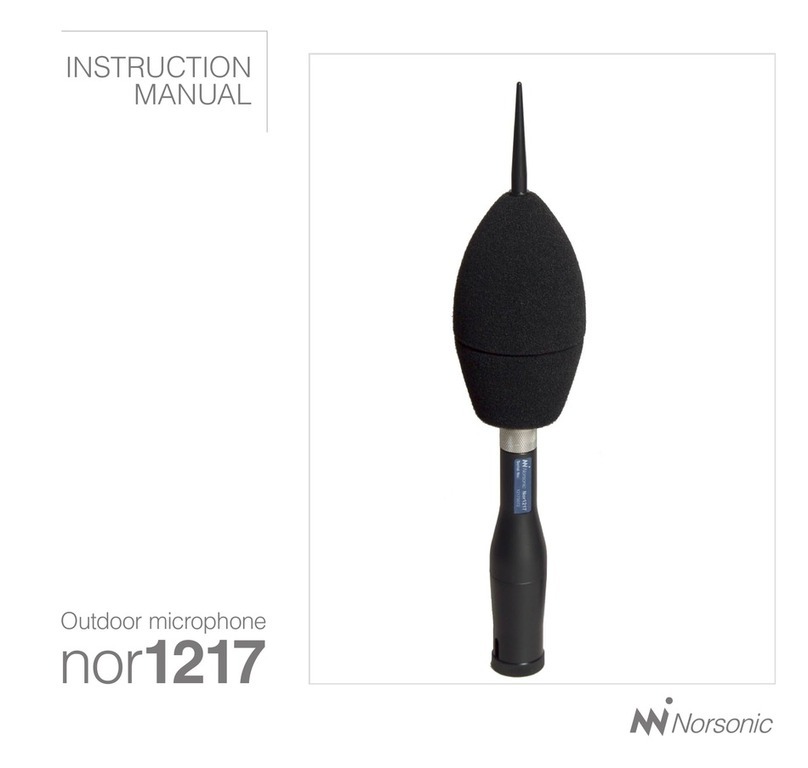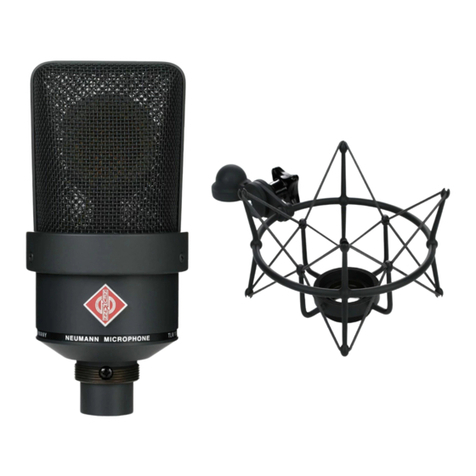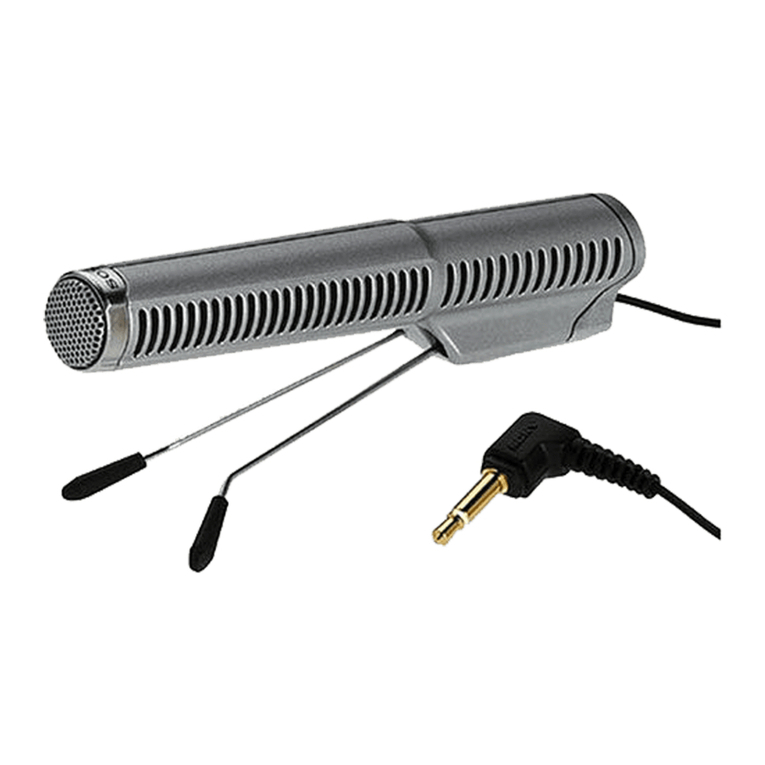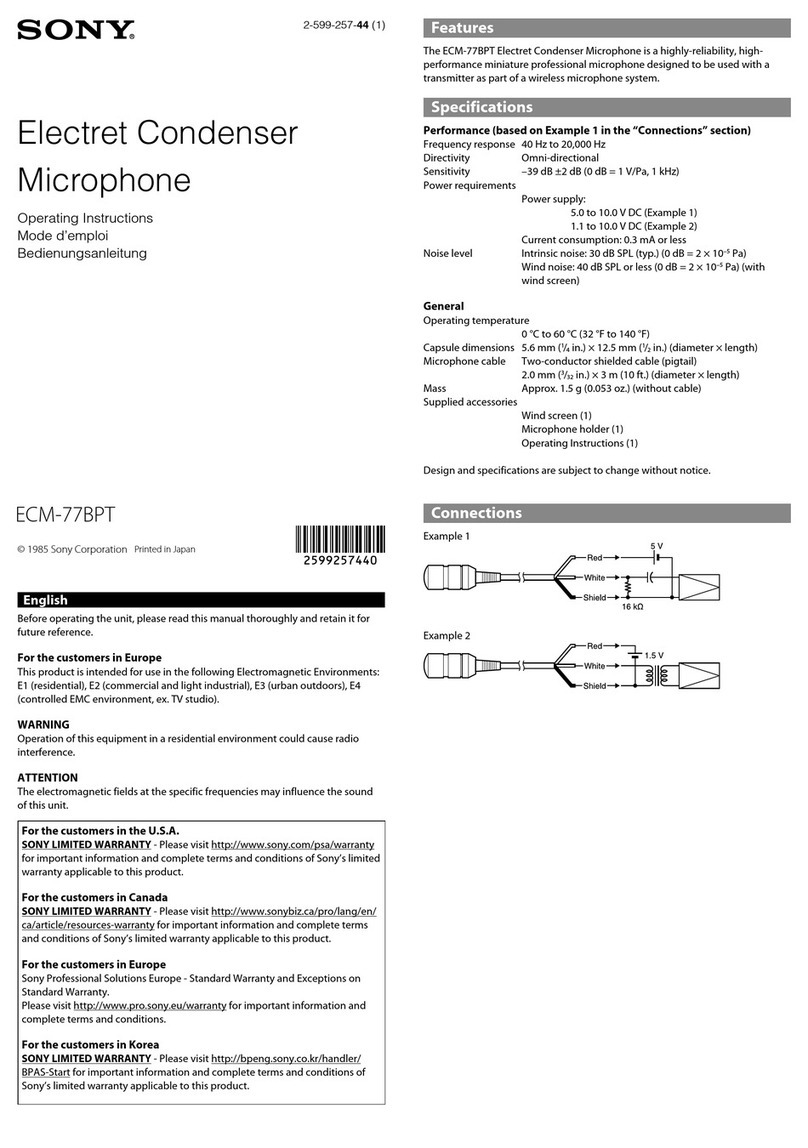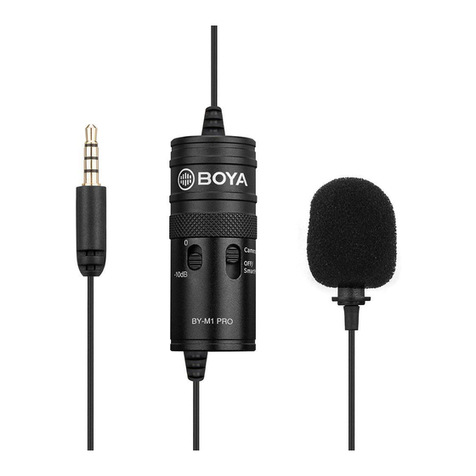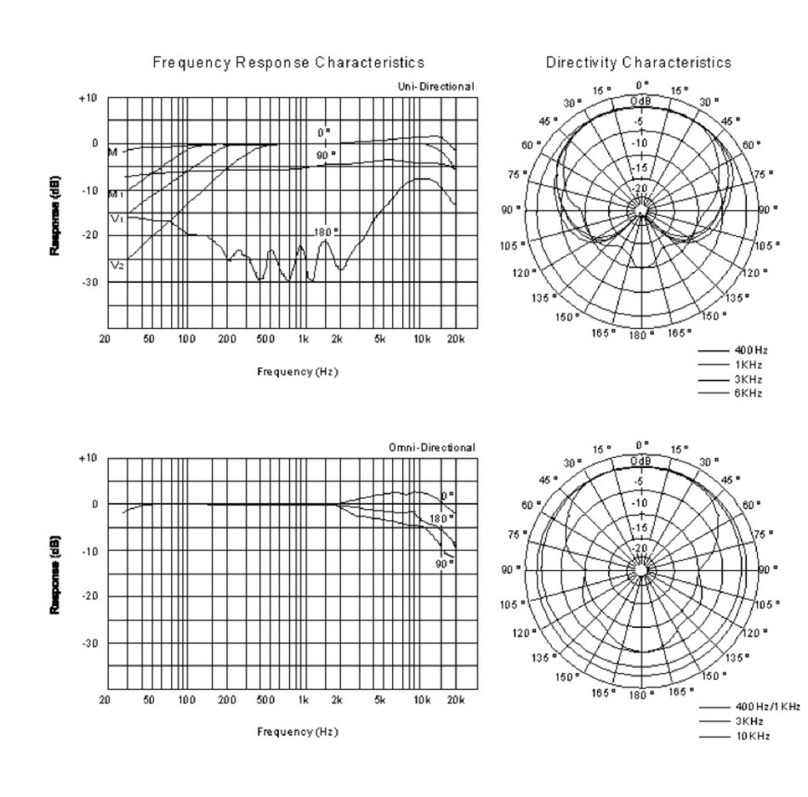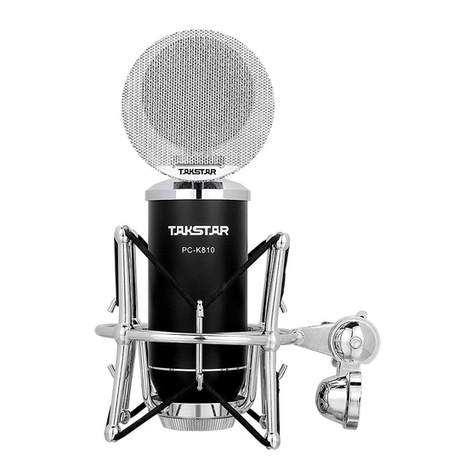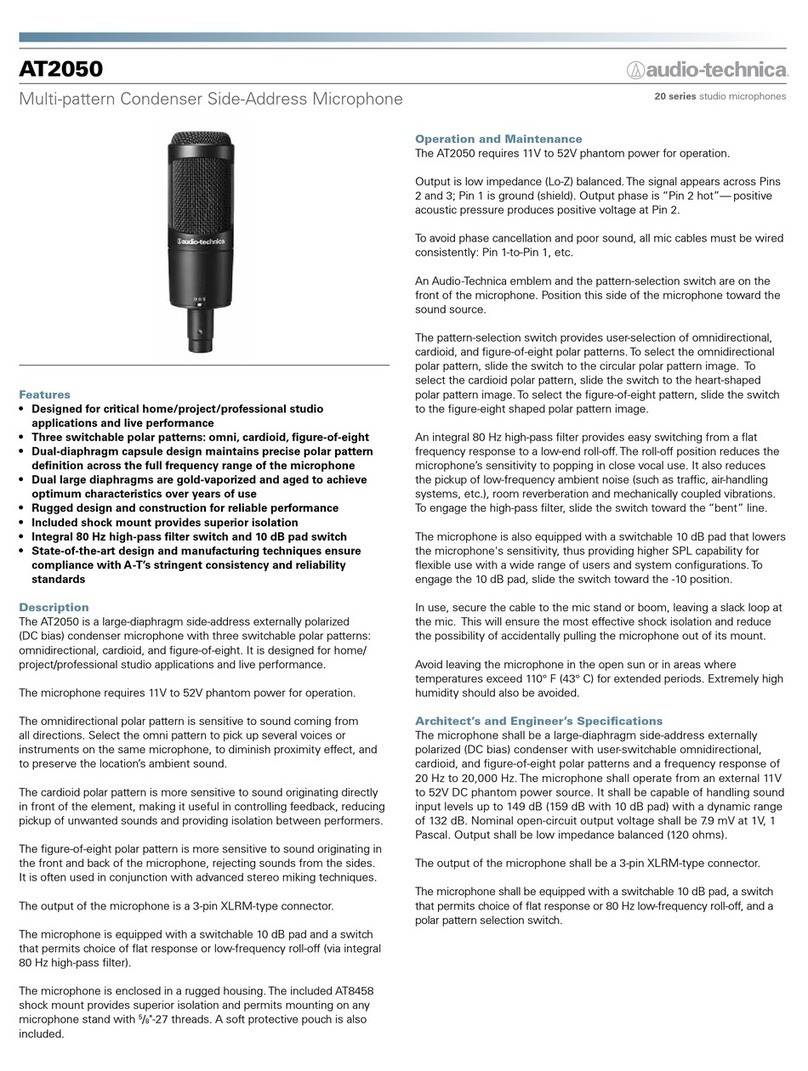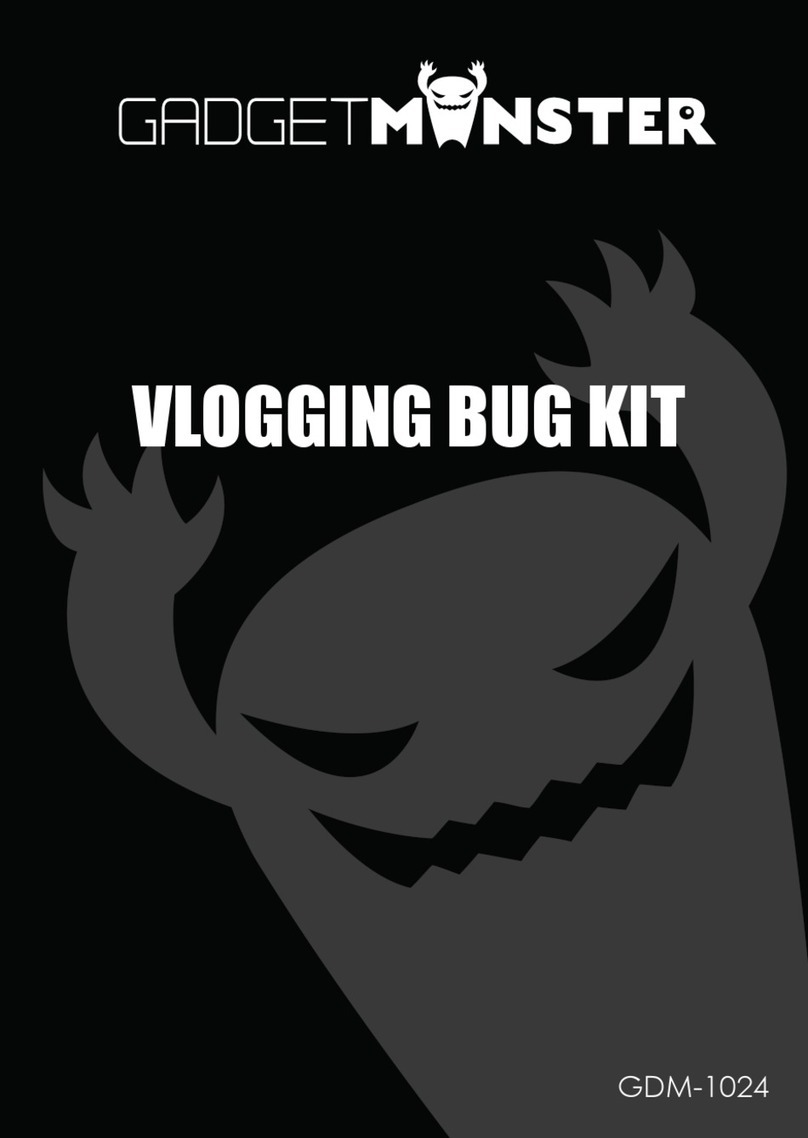Norsonic nor1216 User manual

INSTRUCTION
MANUAL
Outdoor microphone
nor1216


Outdoor microphone
nor1216

Nor1216 – User Guide
Im1216_1Ed1R3En – October 2016 edition
Norsonic is a registered trademark of Norsonic AS.
Every effort has been made to supply complete and ac-
curate information. However, Norsonic AS assumes no
responsibility for the use of – or for the consequential dam-
age resulting from the use of – this information and/or the
instrumentation described herein. Furthermore, Norsonic AS
assumes no responsibility for any infringement of the intel-
lectual property rights of third parties, wherever applicable,
which could result from such use.
Norsonic AS reserves the right to amend any of the informa-
tion given in this manual in order to take account of new
developments.
If you wish to communicate with us, please feel welcome
Our address is:
Norsonic AS, P.O. Box 24, N-3421 Lierskogen Norway,
Find us on the web: www.norsonic.com
Tel: +47 3285 8900
Fax: +47 3285 2208
E-mail: [email protected]
Copyright © Norsonic AS 2012
All rights reserved

v
Norsonic Nor1216
Instruction Manual
v
Contents
Chapter 1 Introduction ......................................................................................................... 1
Chapter 2 Assembling .......................................................................................................... 2
Mounting on a mast ....................................................................................................................... 3
Grounding and lightning protection ............................................................................................ 3
Chapter 2 Microphone calibration....................................................................................... 4
Chapter 3 Technical description.......................................................................................... 5
Electrical description ..................................................................................................................... 6
System check ................................................................................................................................. 8
Frequency response ...................................................................................................................... 9
Self-noise ........................................................................................................................................10
Cables and cable length ..............................................................................................................11
Directional response .....................................................................................................................12
Frequency response .....................................................................................................................13
Self-noise and wind ...................................................................................................................... 14
Chapter 4 Connecting the Nor1216 to Sound Analyser Nor140 and
Sound & Vibration Analyser Nor150 ................................................................15
Connecting to Nor140 ........................................................................................................... 16
Connecting to Nor150 ........................................................................................................... 17
Chapter 5 Maintenance........................................................................................................18

vi Content
Chapter 6 Specifications .....................................................................................................19
Mounting direction ........................................................................................................................ 19
Acoustic performance ..................................................................................................................19
General ....................................................................................................................................19
Frequency response ..............................................................................................................19
Directional response ..............................................................................................................19
General ...........................................................................................................................................19
Conformity ..................................................................................................................................... 20
Protection provided by the enclose ........................................................................................... 20
Accessories and spare parts ...................................................................................................... 20

Outdoor microphone
nor1216


1
Norsonic Nor1216
Instruction Manual
1
Introduction
The outdoor microphone Nor1216 is a measurement
microphone for all-weather conditions. It is intended for
temporary as well as permanent outdoor applications.
The microphone contains elements for protecting the
microphone cartridge from rain and snow, dust and
insects, satisfying IP 55 requirements.
Further, compared to a standard measurement micro-
phone, the Nor1216 improves the measurement accu-
racy by reducing the wind noise and by improving the
directional response for sound from different directions.
Combined with a suitable sound level meter instrument
including a frequency response correcting function,
the Nor1216 satisfy Class 1 specification requirements
according to IEC61672-1 and similar national standards
for a sound level meter class 1.
The microphone is intended for vertical mounting only
since the act of gravitation forms a part of the rain
protection system. The reference direction may,
however, be selected to be vertical or horizontal based
on the applied frequency response compensation in
the sound level meter.
The outdoor microphone may be calibrated with
a normal sound calibrator suitable for ½” working
standard microphones (WS2) and without the need for
extra accessories. Access to the microphone cartridge
is easily gained by dismounting the upper part of the
outdoor microphone.
The base of the Nor1216 is made of an electrical insulat-
ing material. The microphone body will be fully insulated
from the mounting mast thereby reducing pick-up of
electrical hum and noise.
For verification of proper operation, the microphone is
equipped with a system check facility, where an electri-
cal signal applied on one of the terminals are returned
after passing through the complete signal chain, thus
verifying proper operation of the microphone cartridge,
preamplifier and microphone cable.
The Nor1216 is equipped with the standard 7-pin Lemo
connector for microphone preamplifiers. However, the
current consumption has been increased in order to
raise the temperature above the ambient. Nor1216
is mainly designed to be used with the Nor140 and
Nor150 Sound Analyser . These instruments have the
requested frequency compensation and deliver the
required current.
Please note that Nor140 instruments with serial number
lower than 1405079 may need to be upgraded in order
to deliver the required current. Contact your supplier for
further information.

2Chapter 2
Assembling
Assembling
The outdoor microphone Nor1216 is shipped fully as-
sembled. However, in order to mount the microphone
cable the unit has to be opened.
Depending on the application, you will need a mast
or tripod for mounting the microphone system and
possibly devices for proper grounding and lightning
protection, see below.
We recommend cable type Nor1408A, which
comes in standard lengths of 5, 10, 15, 20, 30 and 50
metres – other lengths are available on request. This
cable is Teflon®-insulated and hence absorbs very lit-
tle water, which is important to retain high insulation in
all weather conditions. The mantle is made of polyure-
thane to ensure a robust cable, yet flexible at low tem-
peratures. If you need weather-protected connectors,
we recommend cable type Nor1485.
Unscrew and remove the upper part of the microphone
consisting of birdspike and windscreen as one unit.
Do not remove the windscreen from this upper part as
this may destroy the weather protection and alter the
acoustic performance.
Pull up the assembly of microphone cartridge and
preamplifier: See picture on this page. This assembly
is mounted to the base unit by the friction of an O-ring
and may be pulled straight up.
If the microphone is to be mounted on a mast,
mount the base unit and let the microphone cable
go through the base unit. Connect the cable to the
Birdspike
Wind, dust and
water protection
Upper part
Microphone cartridge
Nor1227 or Nor1225
Microphone preamplifier
Nor1209A
Base
Connector/cable
Optional tripod adaptor
with tension relief
O-rings

3
Norsonic Nor1216
Instruction Manual
preamplifier and mount the assembly of microphone
cartridge and preamplifier. After mounting of the
upper protection part, the outdoor microphone is
ready for use. However, we recommend you to test the
unit together with the measuring instrument by apply-
ing a calibrator before the upper part is mounted.
The unit is delivered with an adaptor for mounting
on a tripod. The cable is then led through a slot in the
side of the adaptor. The base screw has a threaded
hole like those commonly used for cameras (3/8"
UNC). The base screw also forms a tension relief for
the cable.
Mounting on a mast
For permanent installations we recommend to mount
the Nor1216 on a pole rather than using the 3/8” cam-
era tripod treads. Remove the optional tripod adapter
with tension relief to gain access to the pole mount
threads. The pole mount threads are standard 1” ac-
cording to ISO228-BSP (British Standard Pipe)
If the mast is high and you need to make regular
calibrations or other service operations, we recom-
mend to use a mast that can be tilted or a telescopic
mast. Norsonic can supply different masts on demand.
We recommend to place the cable to be mounted
inside the mast for protection. A cable flapping onto
the mast in windy conditions may create excessive
noise and ruin the accuracy of the measurement.
Grounding and lightning protection
If the outdoor microphone assembly is the highest ob-
ject in the vicinity when mounted, it may be exposed to
lightning strokes. We recommend to use a conductive
mast and to ground it properly. A rod in proper con-
tact with the conductive mast should be made at the
side and 50 cm above the tip of the microphone. The
rod should be placed at least 25 cm to the side of the
microphone assembly and have a diameter less than
10 mm to avoid interference with the directional prop-
erties of the microphone.
Safety considerations may require the screen of the
microphone cable to be properly grounded and that
the internal conductors are clamped for high voltage
protection.
We recommend making the combined grounding
for the cable and instrument at one point only in order
to reduce the risk of pick-up of hum and electromag-
netic noise.
Verify the noise floor of the complete system after
installation is completed to ensure it is below the lower
end of the required measurement range. If a quiet lo-
cation is not available, the noise floor may be meas-
ured by substituting the microphone with a dummy mi-
crophone like Nor1448. As an alternative the Nor1447
adaptor terminated with a short-circuit or a 50 ohm
BNC termination is also a suitable device for making
this test. A sound calibrator in OFF-mode may also be
used to attenuate the external noise. A ½” microphone
normally requiring polarization voltage may also be
used without polarization voltage. It will then have a
very low sensitivity.

4Chapter 3
Microphone calibration
Microphone
calibration
The Nor1216 can be calibrated with a sound calibra-
tor for ½” microphones without the need for special
couplers. We recommend using Nor1251 (1000 Hz) or
Nor1253 (250 Hz).
Unscrew the upper part of the microphone to gain
access to the microphone cartridge. Mount the calibra-
tor slowly and carefully while turning the calibrator and
switch it on. See figure.
If the calibrator frequency is 250 Hz, adjust the
reading to be the level stated for the calibrator, e.g.
124,0 dB for Nor1253 with 124 dB specified level.
If the calibrator frequency is 1000 Hz, adjust the
reading to be 0,1 dB below the stated calibrator level,
e.g. 113,9 dB for Nor1251 calibrator with a stated level
of 114 dB.
Mount the upper part after finishing the calibration.

5
Norsonic Nor1216
Instruction Manual
Technical description
The outdoor microphone Nor1216 is based on a ½”
working standard microphone type WS2F according
to IEC 61094-4.
Two types of microphones are offered;
- Nor1225, a free field microphone requiring 200V
polarisation voltage.
- Nor1227, a free field self polarised microphone.
Both microphones have a nominal sensitivity of 50 m V/
pa. However, each microphone is individual calibrated
and may differ slightly from this value.
The upper part of the Nor1216 consists of windscreen,
rain hood, dust mesh and birdspike and protects
the microphone from rain, snow, dust and insects.
Both the rain hood and the dust mesh are made of a
water-repellent fabric open for the sound. The sound
is reaching the microphone through nine slots placed
equidistantly around the circumference of the circular
body of the upper part. The mechanical parts with the
birdspike is also important for the directional response
of the complete microphone system.
The upper part may be removed as one unit and will
thus give easy access to the microphone cartridge for
testing and calibration.
Birdspike
Windscreen
Microphone cartridge
Rain hood
Dust mesh
Preamplifier
Plate for type and
serial number
Base
Mounting threads
Unscrew the
upper part
here!
Upper part

6Chapter 4
Technical description
The lower part consists of the base, the microphone
cartridge and the preamplifier Nor1209A. A normal
microphone cable supplied with Norsonic sound level
meters, like Nor1408A, should be used for connec-
tion to the sound level meter instrument. An adaptor
for mounting the outdoor microphone on a tripod is
included.
The base is made of black polyacetal (POM). The
material is durable and insulating, thus preventing
electric noise from ground loops through the mast.
Drops of water from rain are kept away from the
microphone diaphragm by the combined act of the
tubular windscreen, the rain hood and the dust mesh.
The upper part of the microphone cartridge is air- and
water tight, and the backside is vented to the air through
the preamplifier. The electrical power consumption is
increased in the Nor1209A preamplifier compared to
an ordinary Nor1209 preamplifier. This increases the
temperature of the microphone some degrees Celsius
above the ambient temperature and prevents conden-
sation and humidity problems.
The Ingress Protection Category for the assembled
microphone is IP55 according to IEC 60529.
Consider the assembly of microphone,
and preamplifier as a single unit when operated in the
field. If disassembled in the field, the performance
may be reduced due to contamination from dust and
humidity.
When Nor1216 substitute a normal measurement
microphone on a sound level meter, a correction of the
frequency response is normally needed to retain the
class of accuracy for the sound level meter, see Speci-
fications. Based on the correction, the reference direc-
tion may be selected to be either horizontal or verti-
cal. Horizontal reference direction is usually selected
for sound approaching the microphone mainly along
a horizontal axis like noise from industry or vehicles.
A vertical reference axis is usually used for measuring
the noise from aircraft.
The sound analyser Nor140 and Nor150 have cor-
rection network where the reference axis for the out-
door microphone Nor 1216 may be selected to be hori-
zontal or vertical
See separate description in this manual on how to
configure the Nor140 or Nor150.
Electrical description
The power to the Nor1216 will normally be supplied
from a Norsonic sound analyser Nor140 or Nor150
instrument and the user does not need detailed
knowledge of the interconnection. Alternatively, the
microphone unit may be supplied either from a single
supply in the range 28 V to 32 V or a symmetric sup-
ply in the range ±14 V to ±16 V. The latter alternative
is recommended. The connection is shown on the
adjacent figure. (Outside view for the connector).
Rain hood
Microphone
cartridge
Dust mesh
Wind screen

7
Norsonic Nor1216
Instruction Manual
Pin 3, allocated for polarization voltage, shall be
terminated to signal ground (pin 2) for the micro-
phone cartridge Nor1227. When the microphone unit
is equipped with the Nor1225 microphone cartridge
where polarization voltage is needed, 200 V must be
supplied to this terminal.
The supply voltage will affect the maximum sound pres-
sure that can be measured. For ±15 V or +30 V supply,
the maximum peak value exceeds 10 volt corresponding
to 140 dB peak sound pressure level for the Nor1227 /
Nor1225 microphone cartridge (50mV/Pa).
By the use of the “high level” option in Nor140, signals
with peak values up to 150 dB may be measured with
the microphone Nor1225.
1
2
3
4
5
7
6
Signal ground
Polarization voltage
Signal output
Not connected
Power supply +
Power supply -
5
6
1
4
3
7
2
V+
NC
System check
Output
Heater
resistor
Vpol
V-
GND
NOTE: Nor140 with serial number below
1405079 must be upgraded in order
to deliver the required current for the
heater resistor which is used in Nor1216
to rise the temperature of the microphone and
preamplifier some degrees above the ambient
temperature.
NOTE: The high current consumption
due to the heater resistor requires that
the Nor140 is powered externally. Us-
ing the internal batteries may lead to
increased self noise.
The figure below shows a simplified electrical circuit
diagram of the complete outdoor microphone. The
microphone cartridge is connected to the preamp-
lifier input terminal. The figure below shows the output
connector seen from outside.

8Chapter 4
Technical description
System check
The system check terminal, pin 1, shall be terminated
to signal ground or the signal output when the micro-
phone system is in normal use. For checking the sys-
tem, a test signal may be supplied, e.g. an AC signal
of 1 volt – 1000 Hz. The signal is transmitted to the
preamplifier input through a capacitor with a very low
capacitance (about 0.8 pF) and further to the signal
output.
The system check is a robust and simple method for
verifying a microphone system. It measures the change
in the capacity of the microphone cartridge. Nominal
cartridge capacity of a ½” microphone is 18pF. The
test signal is feed through a fixed 0,8pF capacitor, and
the system check voltage is measured as a function of
the attenuation between the 0,8pF capacitor and the
microphone cartridge with a nominal capacitance of
18 pF.
A typical level for the returned signal is 45 mV with an
excitation of 1 volt corresponding to a sound level of
92 – 95 dB dependant of the microphone cartridge ca-
pacistance. The signal may be used for verification of
correct operation of the cable and preamplifier. Even
a malfunctioning microphone may be detected since
this is normally accomplished by a change in the mi-
crophone capacitance. A very low signal is returned in
case of a short-circuit in the microphone.
A 200V polarised microphone will show approxi-
mately 2 dB higher level if the 200V disappear due to
the lost tension and thereby decreased capacity in the
diaphagma when the 200V is off.
The sound analyser Nor140 and Nor150 have a
build-in signal generator that deliver the required sig-
nal for system check. The signal is switched on/off
from the instrument menu. See separate description.
Pin 1, System
Check input Pin 4,
Output
Pin 2,
Ground
Microphone cartridge 18pF
0,8pF

9
Norsonic Nor1216
Instruction Manual
0.1
1 10 100
Frequency [Hz]
1k 10k 100k
8
7
6
5
4
3
2
1
0
1
2
dB
Typical frequency response for the preamplifier Nor1209A
Frequency response
The typical frequency response for the preamp-
lifier is shown below. The frequency response for the
outdoor microphone system is therefore mainly deter-
mined by the microphone cartridge and the acoustic
performance of the enclosure.

10 Chapter 4
Technical description
-10.0
-5.0
0.0
5.0
10.0
15.0
20.0
6.3 Hz
8.0 Hz
10 Hz
12.5 Hz
16 Hz
20 Hz
25 Hz
31.5 Hz
40 Hz
50 Hz
63 Hz
80 Hz
100 Hz
125 Hz
160 Hz
200 Hz
250 Hz
315 Hz
400 Hz
500 Hz
630 Hz
800 Hz
1.0 k
1.25 k
1.6 k
2.0 k
2.5 k
3.15 k
4.0 k
5.0 k
6.3 k
8.0 k
10.0 k
12.5 k
16.0 k
20.0 k
A C
Frequency [Hz] / Network
Level [dB]
Self-noise
The electrical noise when the microphone is substitut-
ed by an 20 pF capacitor is shown on the graph above.
0 dB corresponds to 1 µV. For a microphone with a
sensitivity of 50 mV/Pa (Nominal value of Nor1227 or
Nor1225), 0 dB voltage also corresponds to the normal
reference pressure for sound: 20 µPa and the noise
level may be compared with sound pressure level di-
rectly.
Typical self noise of the microphone system when the microphone is substituted by a capacitor with similar
capacitance as the microphone. Note that the acoustical self-noise for a real microphone will be higher due to
thermal noise in the microphone cartridge.

11
Norsonic Nor1216
Instruction Manual
140
130
120
110
100
90
10 m 50 m 100 m20 m 200 m 500 m
20 kHz
10 kHz
5 kHz
dB
Cable length (120 pF/m)
Level
Cables and cable length
The Nor1216 with its preamplifier Nor1209A has excel-
lent driving capability for long cables. The signal out-
put from the microphone preamplifier will be loaded by
the capacitance of the cable between the microphone
system and the instrument. The capacitance will in-
crease proportionally with the length of the cable. A
typical value for microphone cables from Norsonic is
120 pF per metre. Hence, a cable with length 100 m,
will load the output with a capacitance of 12 nF. For
lower frequencies there are seldom problems with
long cables. However, when the signal contains the
combination of high amplitude and high frequency,
the capacitive loading will lead to high output current.
A limited current capacity will set limits for the maxi-
mum slew-rate for the signal. The figure below shows
the maximum level as function of cable length and
frequency. 20 kHz corresponds to the bandwidth of
the microphone system with the normal microphone
Nor1225 or Nor1227.

12 Chapter 4
Technical description
100 10 k 20 k
1 k
0
1
2
3
4
Frequency [Hz]
+/- 30 deg – Horizontal reference
Directional response
An outdoor microphone system like Nor1216 may
form a part of a sound level meter when applied for
environmental noise monitoring. The combination of
microphone and instrument shall therefore satisfy all
requirements in the international standards for sound
level meters, specified in IEC 61672-1. Ideally, the mi-
crophone shall have the same sensitivity for sound
from any direction. The IEC 61672-1 specifies toler-
ance limits for the directional response.
The directional response of a microphone is the ra-
tio of the free field response at a particular frequency
as a function of angle of sound incidence to the re-
sponse in the reference direction.
The upper adjacent figure shows the directional re-
sponse for Nor1216, when the reference axis is verti-
cal, for the frequencies 1000 Hz, 4000 Hz and 8000
Hz.
IEC 61672-1 specifies tolerance limits for any fre-
quency. The limits are depending on the angle from
the reference axis and the standard specify tolerance
limits for angles up to ± 30°, up to ± 90° and up to ±
150° from the reference axis. The lower adjacent figure
shows the typical max. deviation for the sector up to
± 30° from a horizontal reference axis together with the
applicable tolerance limits for a Class 1 sound level
meter.
Table of contents
Other Norsonic Microphone manuals
Popular Microphone manuals by other brands
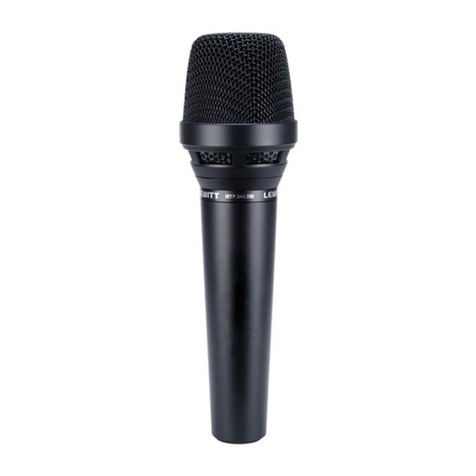
Lewitt
Lewitt MTP 240 DMs user guide
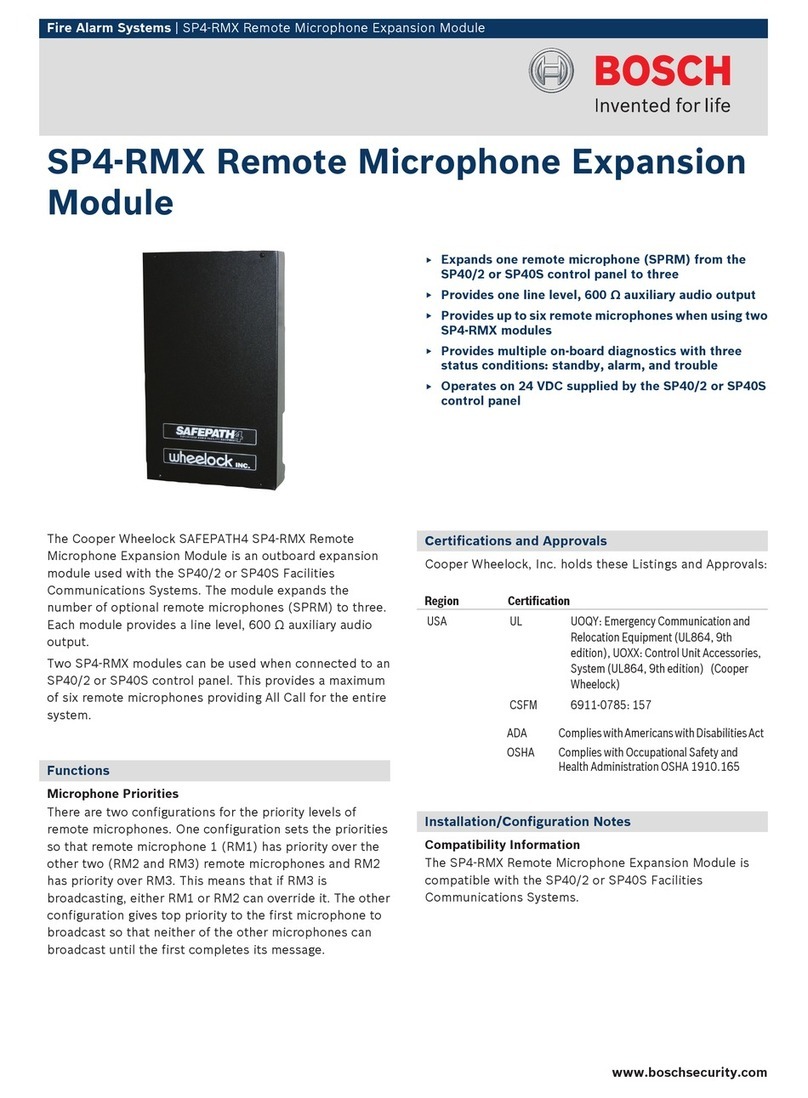
Bosch
Bosch SP4?RMX Specfications

Neumann.Berlin
Neumann.Berlin KM 66 datasheet

Audio Engineering Associates
Audio Engineering Associates R88 user manual
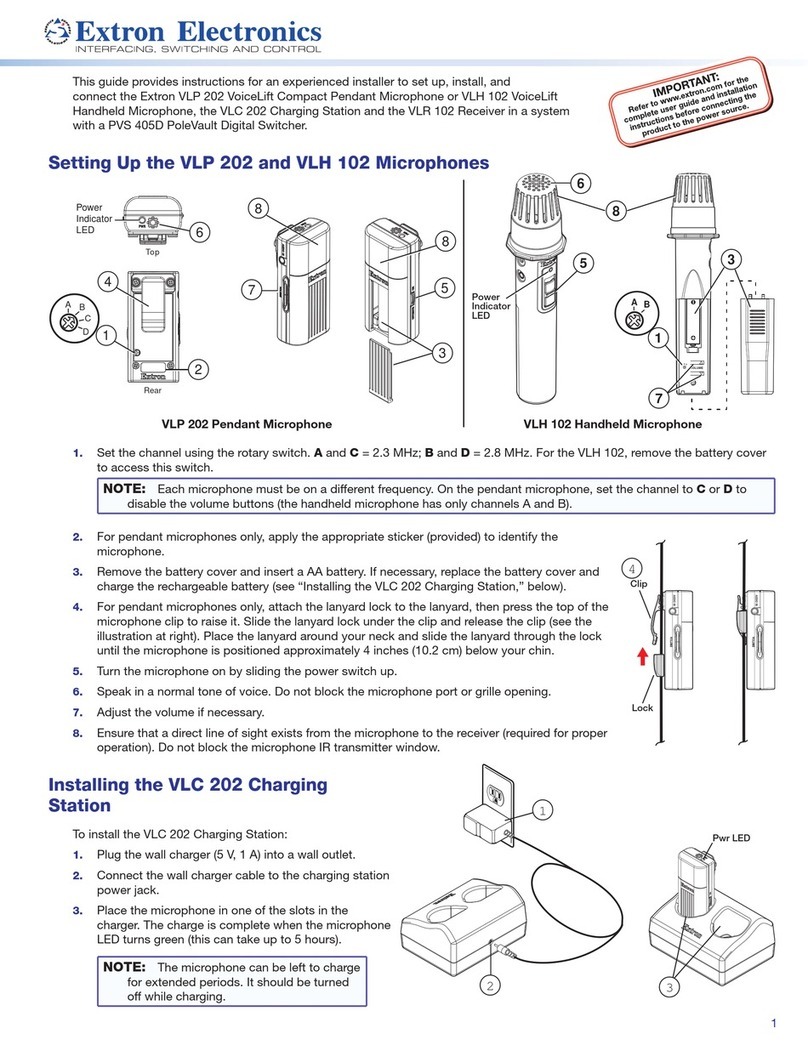
Extron electronics
Extron electronics VoiceLift VLP 202 Setting up
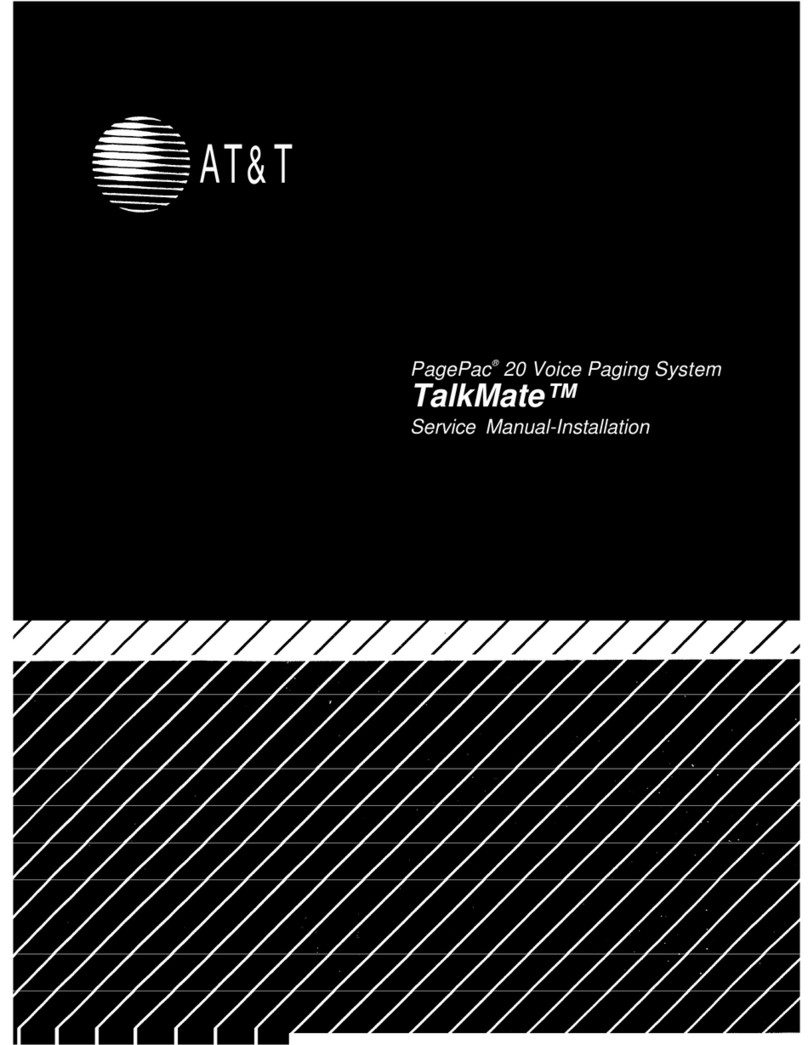
AT&T
AT&T TalkMate PagePac 20 Service manual-installation
